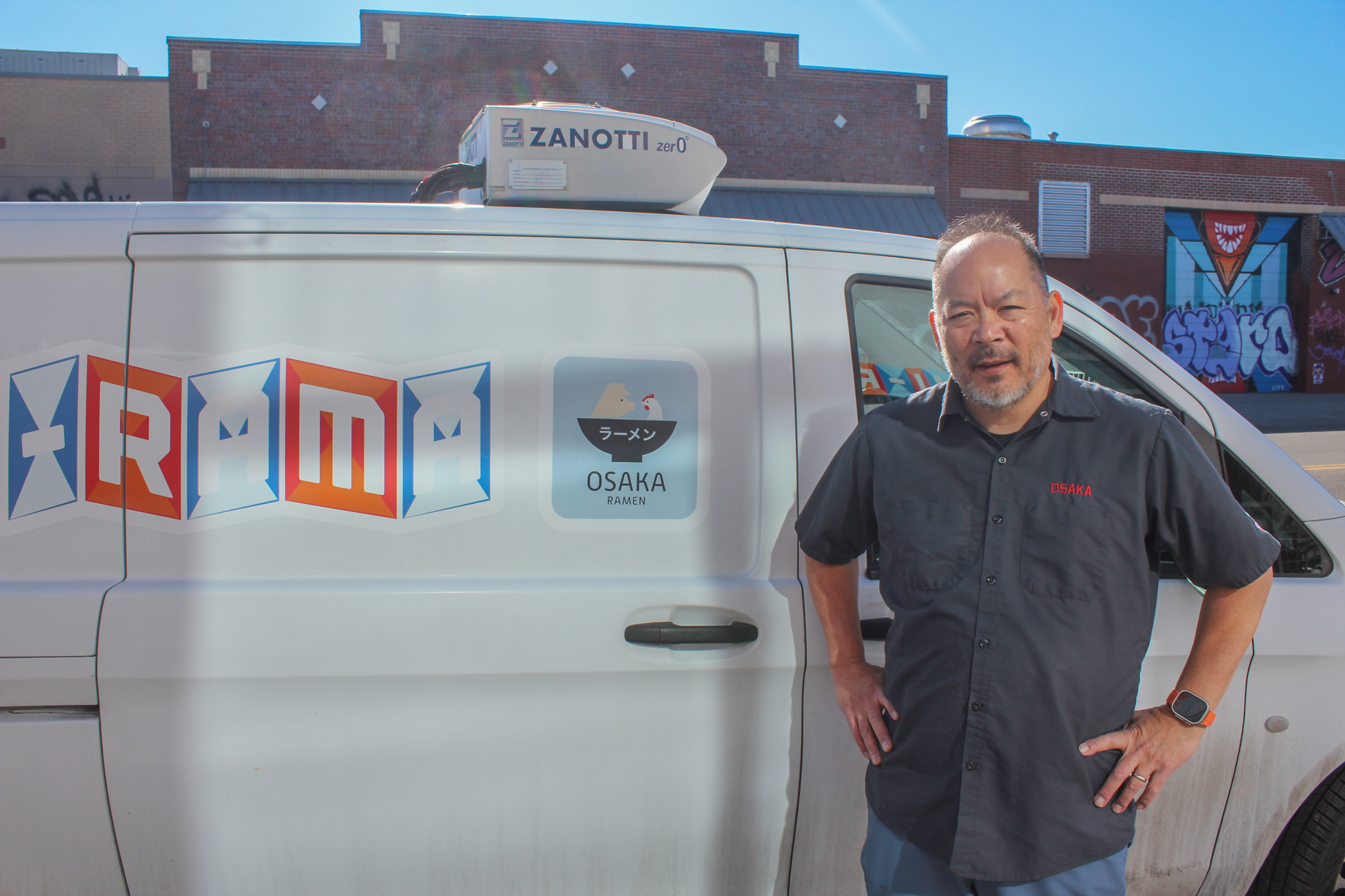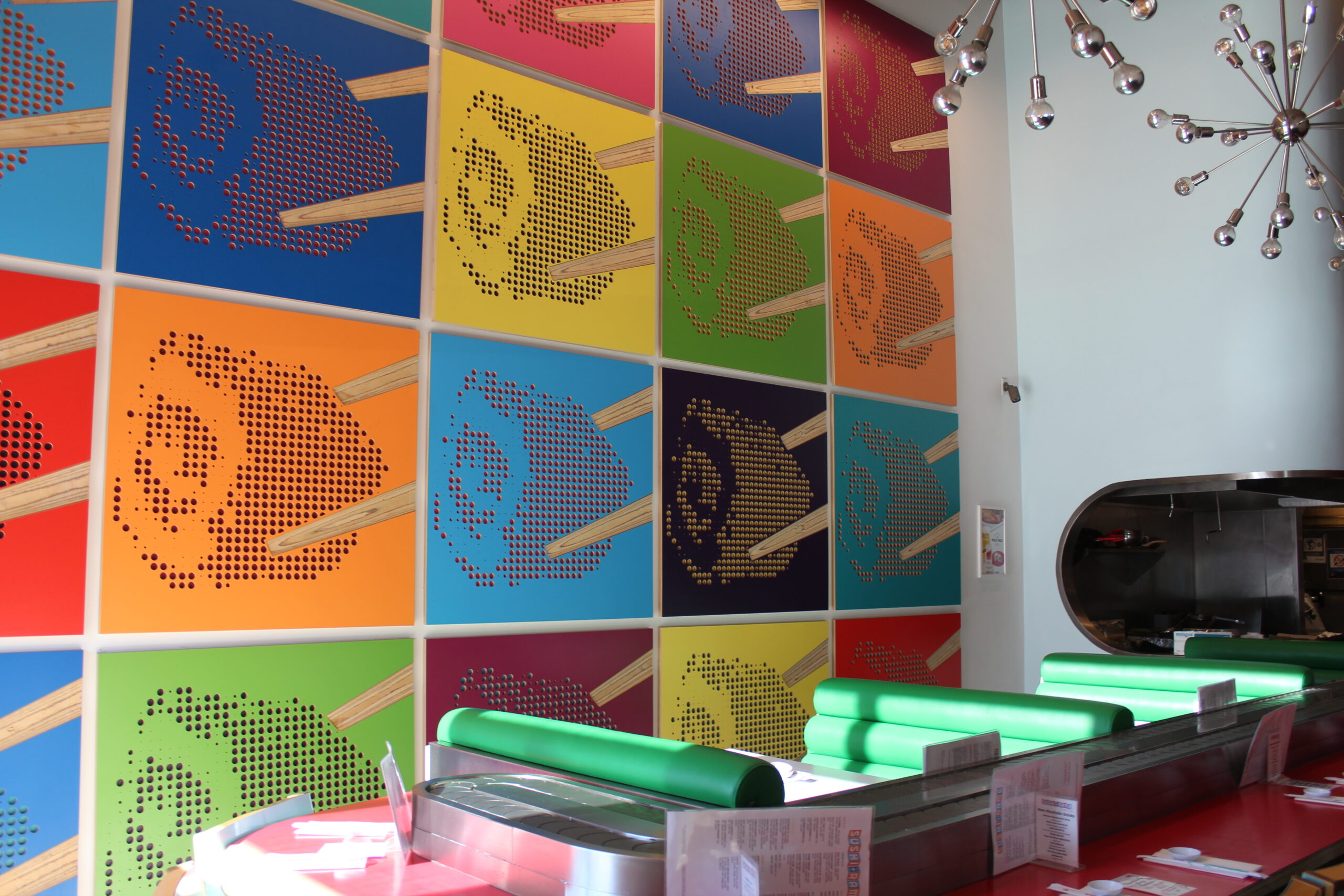
Jeff Osaka poses in RiNo, where he recently closed Osaka Ramen. (Max Scheinblum/BusinessDen)
Since 2015, Osaka Ramen has been a RiNo staple.
But the shop at 2611 Walnut St. in Denver served its final bowl last month. It’s just the latest closure for owner Jeff Osaka, who also shuttered four out of five of his Sushi-Rama restaurants about a year ago. One remains open in RiNo.
The restaurateur recently sat down with BusinessDen to discuss the closures and his thoughts on Denver’s food scene. His answers have been edited for length and clarity.
On closing — and the tip credit: COVID really hit us hard, and we’ve been kind of running on reserves for the last four years. We’re still making money, but it’s just become more challenging. The big issue right now is with the tip credit, trying to get more on our end. Over the last really four years, the minimum wage has gone up. And people still think it’s a minimum wage issue, but it’s really the tip credit.
My tip employees make plenty of money. They’re more fast-casual, but still making upwards of like $35, $38 an hour, which is way above minimum wage and cost of living. And I’ve always paid my back of the house staff above minimum wage too.
On a 4% “living wage” charge: We charge a 4% living wage (fee) and we’ve been doing that for I want to say six years. There’s no gratuity or tax on top of that. But it goes directly to the back of the house. So at the end of the month, it’s all divvied up by the amount of dollars they worked. And it raises their pay $2 or $3 an hour.
The pay and equity between front and back of the house has always been a little lopsided. And really, gratuity on the front of the house hasn’t gone down — we still average 19.5% gratuity, almost 20% — and the customer has an option to remove that from their bill if they want to. But most people keep it, I’m guessing. Out of the six years, we probably have only had a handful, probably not more than half a dozen or so, that’s really arguing against it.
On closing Sushi-Rama locations: Same thing, we’re making money, but just the work we’re putting into it was with very little reward on our end. It was a struggle to give people raises and bonuses like I normally do. And we just happened to find a buyer that wanted all four of them. So we didn’t really make any money out of that sale.
The original intention for opening all these Sushi-Ramas was to build them up to maybe 10 and then sell them outright, try to profit a little from that. But like I said, COVID hit, our growth stopped, we stopped opening restaurants in 2022.
On RiNo changes: Ten years ago, I was one of the few restaurants down here. Few others, like Crema, the coffee shop, or Populist, which is now Mister Oso. I’m trying to think of what else, but not much.
Edens bought all the buildings that my partner had. They bought six buildings and a couple of parking lots in their area. Then they brought in some bigger names like Patagonia, Burton.
They’re a large group out of D.C. and they’ve done a lot of development there and in Texas. It’s kind of created a different vibe down here, though.
I think it’s a little too commercial now. It used to be a little gritty down here, which I liked.
On the rise of remote work: You used to have to circle the block like 10 times just to get a parking space, but now it’s pretty easy. We used to be open for lunch, but we started closing for lunch last summer partly because of that. And the weather, it was just so hot. And it helped us save on labor too.
But it’s just different now. I remember in the ’80s working at a restaurant in San Francisco, and almost every table for lunch had a bottle of wine on the table. You don’t see that anymore.

Inside Sushi-Rama’s sole remaining location in RiNo. (Max Scheinblum/BusinessDen)
On the contentious relationship between the restaurant industry and the city: I think it’s always been that way. I’m not saying that the city doesn’t see the importance of restaurants. But I think they put us on the back burner, no pun intended. They have other things. They have the unhoused — that’s a big campaign for the mayor.
There’s that big stink about the BRT going down in Colfax. Those businesses are going to suffer too, if they haven’t already. To close the main thoroughfare of the longest street in the country, to close that down, or at least a piece of it, you’re going to see a lot more restaurants closing or just businesses closing in 2025.
Restaurants help the city thrive. It brings in tax money, but it activates the city. Because most people, when they travel to a new city, one of their first things is, “Where am I going to go eat?” And you can’t do that now with fewer options. You’re stuck with the chain restaurants, the Cheesecake Factories downtown.
On rising costs: It just seems like with the restaurant business if it’s not one thing, it’s another. Like now, the bird flu. We put an egg in every bowl of ramen that goes on the table. We used to pay $12 for a case for eggs, which is 15 dozen. Now, we’re paying $85. I foresee other costs going up quickly with tariffs on Canada, Mexico, China. You know, we’re paying maybe 45 bucks a case now for avocados. It’s probably going to double, I would say.

Jeff Osaka poses in RiNo, where he recently closed Osaka Ramen. (Max Scheinblum/BusinessDen)
Since 2015, Osaka Ramen has been a RiNo staple.
But the shop at 2611 Walnut St. in Denver served its final bowl last month. It’s just the latest closure for owner Jeff Osaka, who also shuttered four out of five of his Sushi-Rama restaurants about a year ago. One remains open in RiNo.
The restaurateur recently sat down with BusinessDen to discuss the closures and his thoughts on Denver’s food scene. His answers have been edited for length and clarity.
On closing — and the tip credit: COVID really hit us hard, and we’ve been kind of running on reserves for the last four years. We’re still making money, but it’s just become more challenging. The big issue right now is with the tip credit, trying to get more on our end. Over the last really four years, the minimum wage has gone up. And people still think it’s a minimum wage issue, but it’s really the tip credit.
My tip employees make plenty of money. They’re more fast-casual, but still making upwards of like $35, $38 an hour, which is way above minimum wage and cost of living. And I’ve always paid my back of the house staff above minimum wage too.
On a 4% “living wage” charge: We charge a 4% living wage (fee) and we’ve been doing that for I want to say six years. There’s no gratuity or tax on top of that. But it goes directly to the back of the house. So at the end of the month, it’s all divvied up by the amount of dollars they worked. And it raises their pay $2 or $3 an hour.
The pay and equity between front and back of the house has always been a little lopsided. And really, gratuity on the front of the house hasn’t gone down — we still average 19.5% gratuity, almost 20% — and the customer has an option to remove that from their bill if they want to. But most people keep it, I’m guessing. Out of the six years, we probably have only had a handful, probably not more than half a dozen or so, that’s really arguing against it.
On closing Sushi-Rama locations: Same thing, we’re making money, but just the work we’re putting into it was with very little reward on our end. It was a struggle to give people raises and bonuses like I normally do. And we just happened to find a buyer that wanted all four of them. So we didn’t really make any money out of that sale.
The original intention for opening all these Sushi-Ramas was to build them up to maybe 10 and then sell them outright, try to profit a little from that. But like I said, COVID hit, our growth stopped, we stopped opening restaurants in 2022.
On RiNo changes: Ten years ago, I was one of the few restaurants down here. Few others, like Crema, the coffee shop, or Populist, which is now Mister Oso. I’m trying to think of what else, but not much.
Edens bought all the buildings that my partner had. They bought six buildings and a couple of parking lots in their area. Then they brought in some bigger names like Patagonia, Burton.
They’re a large group out of D.C. and they’ve done a lot of development there and in Texas. It’s kind of created a different vibe down here, though.
I think it’s a little too commercial now. It used to be a little gritty down here, which I liked.
On the rise of remote work: You used to have to circle the block like 10 times just to get a parking space, but now it’s pretty easy. We used to be open for lunch, but we started closing for lunch last summer partly because of that. And the weather, it was just so hot. And it helped us save on labor too.
But it’s just different now. I remember in the ’80s working at a restaurant in San Francisco, and almost every table for lunch had a bottle of wine on the table. You don’t see that anymore.

Inside Sushi-Rama’s sole remaining location in RiNo. (Max Scheinblum/BusinessDen)
On the contentious relationship between the restaurant industry and the city: I think it’s always been that way. I’m not saying that the city doesn’t see the importance of restaurants. But I think they put us on the back burner, no pun intended. They have other things. They have the unhoused — that’s a big campaign for the mayor.
There’s that big stink about the BRT going down in Colfax. Those businesses are going to suffer too, if they haven’t already. To close the main thoroughfare of the longest street in the country, to close that down, or at least a piece of it, you’re going to see a lot more restaurants closing or just businesses closing in 2025.
Restaurants help the city thrive. It brings in tax money, but it activates the city. Because most people, when they travel to a new city, one of their first things is, “Where am I going to go eat?” And you can’t do that now with fewer options. You’re stuck with the chain restaurants, the Cheesecake Factories downtown.
On rising costs: It just seems like with the restaurant business if it’s not one thing, it’s another. Like now, the bird flu. We put an egg in every bowl of ramen that goes on the table. We used to pay $12 for a case for eggs, which is 15 dozen. Now, we’re paying $85. I foresee other costs going up quickly with tariffs on Canada, Mexico, China. You know, we’re paying maybe 45 bucks a case now for avocados. It’s probably going to double, I would say.


